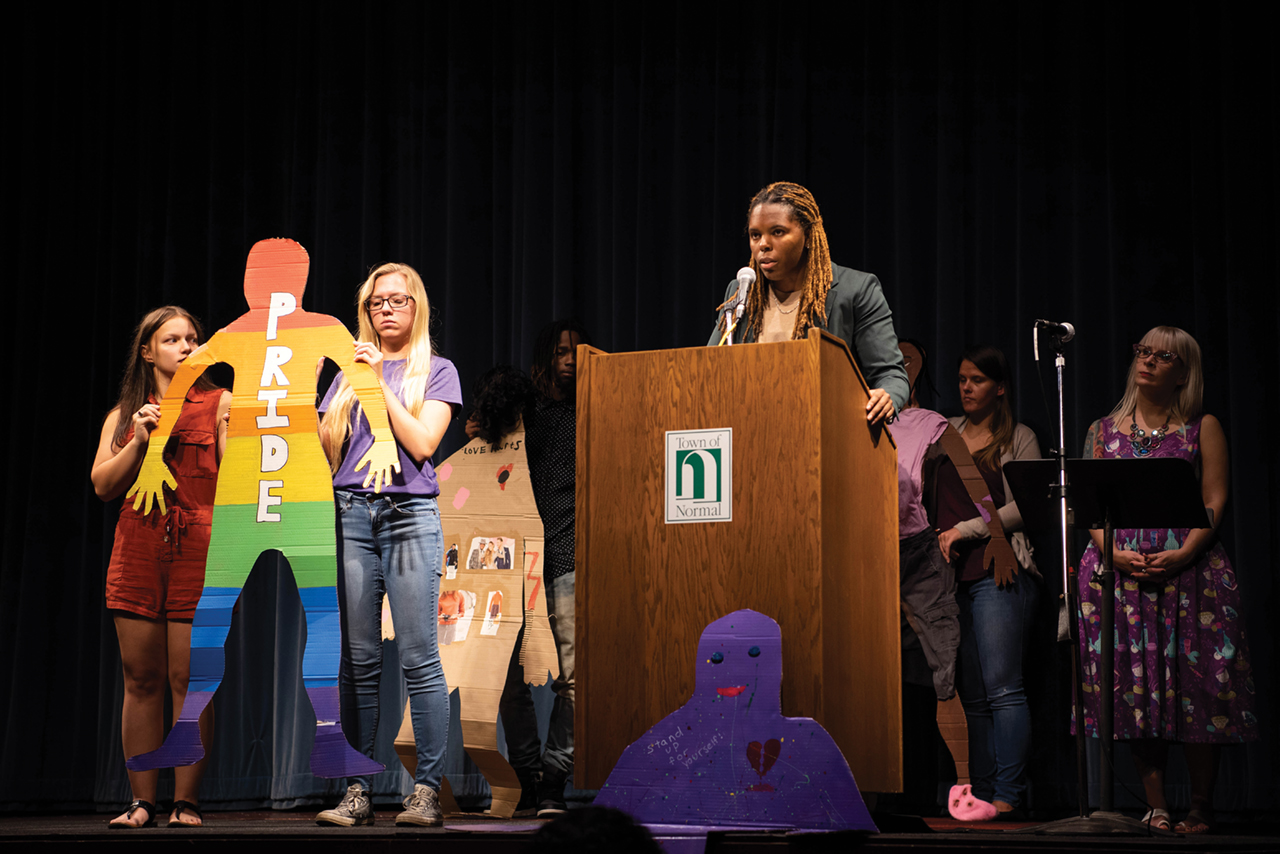Jim was in his mid-20s when his girlfriend abused him. She always had a temper. When she scratched his arms and face, he concealed the wounds until they healed. Until one Thanksgiving morning, when he couldn’t hide recent claw marks from his family.
Rose was abused for the first time on her wedding day. After the ceremony, her husband pulled her into a room and grabbed her wrist so hard that it left a bruise. He told her she embarrassed him, and since she was now his, she had better learn how to behave. On their honeymoon, he told her she was ugly and worthless.
Those are just two of the stories from domestic violence victims that were retold at “Survivors: Local Stories of Domestic Violence,” a performance created by Criminal Justice Sciences Professor Shelly Clevenger and her victimology students. The civic engagement event held last fall at the Normal Theater was designed to raise awareness of domestic violence, while also raising funds for Bloomington-Normal organizations that assist survivors.
The stories came from Clevenger’s research over the past seven years with survivors. The students took quotes from the victims and created cardboard cutout bodies to depict the victimization on one side, and how the survivor coped on the other (see example in the photograph above). The students brought the stories to life through their artistic interpretations.
A man abused by his girlfriend had “weak” and “not a man” spelled out in capital letters across his limbs. A woman raped by her husband had a black broken heart pasted to her chest. Seniors David Kunkle and Diego Quintero were working on the cutout of a woman named “Michelle.”
“It stays with you so much more,” Kunkle said, as he cut the fist-sized heart in two. “Her children were conceived by forced sex.”
On the opposite side of the Michelle cutout, Kunkle depicted what helped her cope. Michelle thought of things that made her happy, like summer, her dog, and music, but she added, “I know that cannot work forever.”
Kunkle changed her black heart to red, but it was still broken, taped together poorly.
“It’s taped together badly because she’s not coping well,” he said.
People had mixed reactions when Clevenger initially told them about the graphic representation. But seeing the image of a survivor makes it more real than only hearing words, she said.
“You can’t unsee it, so it sticks with you. It’s not that I want people to feel bad, but I want them to realize what an issue domestic violence is, that it really does hurt people, people of this community.”
Volunteers from Illinois State and the Bloomington-Normal community represented the survivors. Volunteers included Bloomington-Normal police officers, Illinois State University Police Chief Aaron Woodruff, and College of Applied Science and Technology Dean Todd McLoda. They read the quotes while students stood behind the cutouts. Clevenger chose stories that were inclusive, including those involving men who were abused by women, same-sex relationships, and a woman with a disability abused by her caregiver.
“When we think about domestic violence, we often think about it being a romantic situation, and it’s not just that,” Clevenger said.
It is hard to speak, finally, after years of not speaking. To feel everything, after not feeling anything for so long.
Student Megan O’Meara helped create the cutout of Stella, a victim of physical violence.
“I felt like I got to know her,” said O’Meara, a junior criminal justice sciences major. “This opened my eyes. I was probably doing victim blaming. Now I know the depths they have to go to get away.”
Miltonette Craig, an assistant professor in the Department of Criminal Justice Sciences, attended the performance. She applauded the civic engagement project that drew attention to October’s National Domestic Violence Awareness Month.
“Students aren’t just reading about this in the classroom, they’re making an impact in the community in an extremely meaningful way,” she said. “I like that Dr. Clevenger is showing that anyone can be a victim.”
Stories covered the range of abuse, from sexual and reproductive abuse, to physical, psychological/emotional, cyber, and financial abuse. One of the stories was told through a daughter because the woman committed suicide.
Another story detailed “revenge porn.” A woman detailed how her former boyfriend displayed naked pictures of her on websites—photos she wasn’t aware were taken—along with her name, address, and phone number. Over a year later, men were still showing up at her home. She worried about her safety, stopped teaching, and considered moving away.
There was also an 8-year-old boy who was abused by his mother’s partner, someone he loved and trusted. The victim thought the abuse was normal, until a friend his age told him it was not. When the child told his mother, she believed him and called the police. The boy grew up to be a teacher and a coach who looks for the signs of children who are struggling.
Illinois State alumna Nikita Richards ’06, M.S. ’15, participated in the performance as a representative from the Illinois Council on Women and Girls, which advises the governor and General Assembly on policy issues. She also serves on Illinois State’s Alumni Association Board of Directors.
“I was honored to do it,” Richards said. “These are people you could bump into in the street or people you know. I’m so proud of Dr. Clevenger and the students. If you were a student at ISU even 10 years ago, people wouldn’t talk about abuse, and now our faculty and students are talking about it and sharing resources.”

At the end of the performance, two local survivors shared their stories. Heather walked up to the podium and took a deep breath before she began.
“It was hard. It’s still hard,” she said. “It does not get easier. Life just becomes a different kind of hard. It was hard to wake up, hard to fall asleep, hard to do my job, run a marathon, learn the eggs I liked, do my taxes. It is hard to speak, finally, after years of not speaking. To feel everything, after not feeling anything for so long.”
She and her four children found a home at Neville House, which provides housing and legal and medical support for domestic violence victims. Proceeds from the Survivors event, which raised $1,000, were split between Neville House and the YWCA Stepping Stones Rape Crisis Center. Artwork created together by domestic violence survivors and Clevenger’s students was also sold at the event to raise funds.
This was not the first time Clevenger used her research to create a service learning opportunity for her students. Last spring, students in Clevenger’s Sex Offenders course created a project titled “What were you wearing?” that was shown at Illinois State’s Women’s and Gender Studies Symposium. Students dressed mannequins in clothing similar to what survivors were wearing when they were sexually assaulted, from a military uniform to children’s pajamas. That exhibit drew national attention, with Clevenger invited to display it last fall at an international conference in San Diego.
Clevenger is hoping the Survivors performance will become an annual event. She closed the night with a message of hope.
“I know what you heard was hard. And it’s sad, but that’s not what I want you to leave with. I want you to leave here with hope, that people can get out of these situations and that they can survive.”


